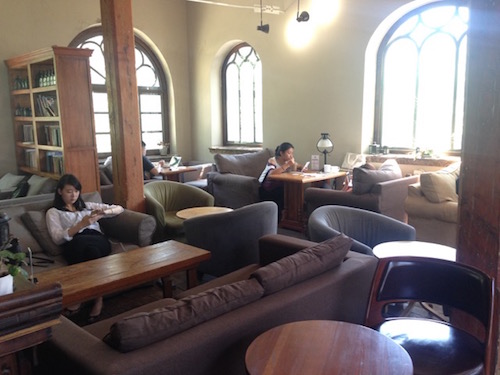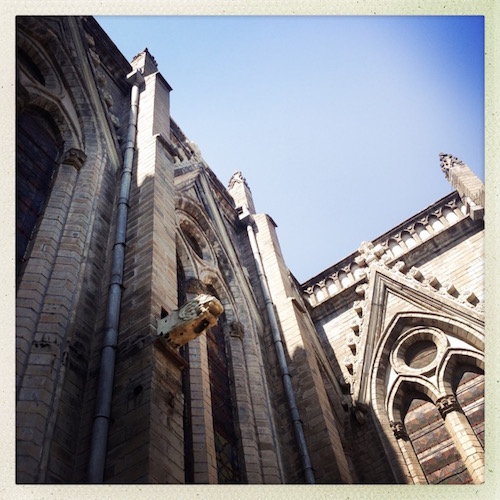
I’ve been meaning to visit Xishiku Cathedral in Xisi ever since I caught a glimpse of it on a bike ride. With its elaborate Gothic marble facade, the building stood in stark contrast against the surrounding hutongs. I finally got my chance last Saturday.
Also known as Beitang or the Church of the Saviour, Xishiku was founded by the Jesuits in 1703. The cathedral moved to its present location in 1887 on the order of the Guangxu Emperor, who went on build Zhongnanhai Park on the original site near the Forbidden City.

The cathedral itself isn’t open to visitors outside of the daily mass times, so we contented ourselves with admiring the architecture and walking around the modest grounds.
To either side of the main building, there are two imposing stone steles covered by Chinese pavilions and mounted on bixi (赑屃), mythological animals with the body of a turtle and the head of a dragon. The steles are inscribed with calligraphy by the Kangxi Emperor, who granted the land to the Jesuits after benefiting from their medical knowledge.

During the Boxer Rebellion, Xishiku was also the site of the Siege of Beitang from June 14 to August 16, 1900. The defense was led by French bishop Pierre-Marie-Alphonse Favier, the cathedral’s architect.
During the siege, over 3,900 people (including 850 orphans) sought refuge in the church. The defense forces consisted of 41 French and Italian marines and two French officers. By Favier’s estimate, between 15,000 to 20,000 members of his congregation died during the Boxer Uprising.
Though the church was locked during our visit, we managed to peek through a crack in the door on the west side. We could make out stunning stained glass windows, which danced in colorful patterns on the floor. The comforting smell of old wood emanated from the pews.
I imagined what Xishiku might look like on Sunday Mass with a full house singing hymns in Chinese. According to one anonymous worshipper, Xishiku’s service is a surprisingly formal affair with "full (correct) modern Western Rite Catholic ceremonies," holy water, incense, and "bows and changes in posture … signaled by a clapper in the west gallery."

Recharging at 1901 Cafe
After our visit to Xishiku, we walked south to the nearby 1901 Cafe to acquaint ourselves with the business end of a cold drink. The cafe is housed in an annex of Xishiku Cathedral and is named after the year of the building’s foundation.
Prices are outrageously expensive (think RMB 48 for an iced Americano), but it’s worth getting a drink just to sit on the small but secluded balcony at the top of the building.


We ordered a pot of iced pomelo tea (RMB 78) and climbed two sets of creaking wooden stairs to the third floor, pausing on the way to breathe in the smell of aged books and admire the cafe’s large, vaulted windows.


The balcony is located just off the last room on the third floor. The door looks padlocked, but it’s not; simply lift the red latch and step out onto your own semi-shaded, private space. We propped our feet up and took our time sipping our team while listening to the sounds of the neighborhood.

Discovering the Inner Life of a Siheyuan at Shijia Hutong Museum
We first posted about Shijia Hutong Museum when it opened to much fanfare in 2014, but I wanted to see the preserved courtyard home for myself.
Located in a storied hutong off Dongsi Beidajie, the sprawling siheyuan complex features bilingual English and Chinese displays that take visitors through hutong history, the house’s famous inhabitants – Danish diplomats, poets, musicians, authors, scientists, academics, generals – and significant periods of cultural and social upheaval.

One of the most interesting displays is a soundproof room with sound bytes from Old Beijing. Though a bit haphazard in design, visitors can select a number of variables on the control panel (season, time of day, historical era, and weather conditions), then press "play" to listen the sounds of hutong life.

I also enjoyed the collection of kitschy objects towards the end, including creepy old children’s toys, tape decks, medieval-looking irons, and hollow lamps with plastic flowers embedded in the middle.
Considering the museum was established with funds from the Prince’s Charities Foundations China, the displays could’ve honestly been a lot better. The museum didn’t always have a clear flow and the text betrayed a distinctly propagandistic bent. The museum is more appropriate for older kids and teens, as it involves lots of reading and learning about historical events and figures.
More pics of Shijia Hutong Museum:



Xishiku Church 西什库天主堂
Free admission. Daily 5am-6pm (Chinese mass every Sun at 8am). 33 Xishiku Dajie, Xicheng District (6617 5198) 西城区西什库大街33号
1901 Cafe Daily 9am-1am.
101 Xi’an Men Dajie, Xicheng District (6616 0335) 西城区西安门大街101
Shijia Hutong Museum 史家胡同博物馆
Tue-Sun 9.30am-4.30pm. 24 Shijia Hutong, Dongcheng District (6525 1069)
东城区东城区史家胡同24号
Sijia Chen is a contributing editor at beijingkids and a freelance writer specializing in parenting, education, travel, environment, and culture. Her work has appeared in The Independent, Midnight Poutine, Rover Arts, and more. Follow her on Twitter at @sijiawrites or email her at sijiachen@beijing-kids.com.




